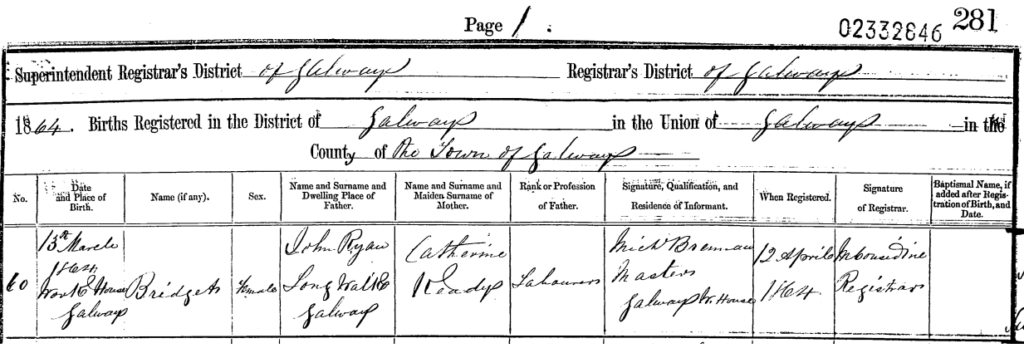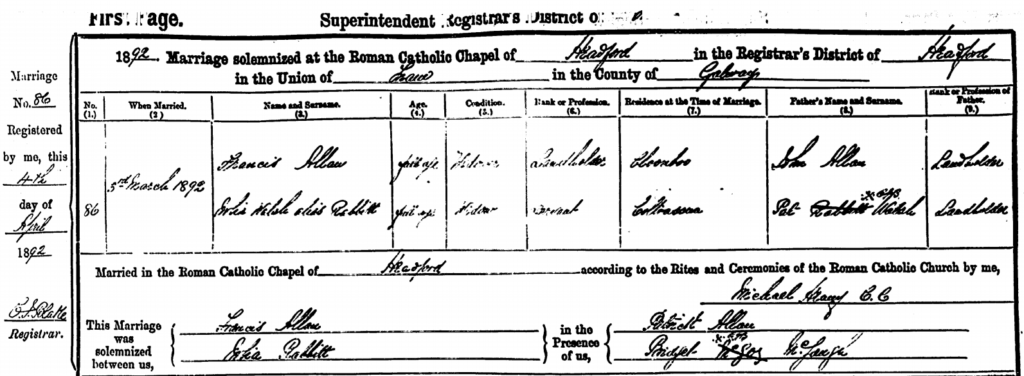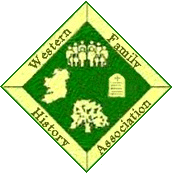Irish Civil Births, Marriages and Deaths
Compiled by Mary Gray
The General Registration Office (GRO) holds all official records of Irish births, marriages and deaths from 1864 and of non-Catholic marriages from 1845.
You can also search these historic indexes and records online for free at the Irish Genealogy website.
This online site holds copies of certificates for research purposes for the majority of records. Some death records may only show an index reference only. If so, record the Name, District, Year, Quarter and Page Number in order to request the document from the GRO.
Civil Registration Districts
Births, marriages and deaths are recorded in districts based on the old Poor Law Unions/Districts. For a full list of these districts please see Peter Higginbotham’s Workhouses website. For instance, Galway is divided into 10 Districts: Ballinasloe, Clifden, Galway, Glenamaddy, Gort, Loughrea, Mountbellew, Oughterard, Portumna and Tuam.
Irish Civil Birth Research
Access to the Irish Civil Birth records are subject to a 100 year rule, so currently it is possible to look up births from 1864 to (inclusive).
Click on “more search options” on the search page if you know the maiden name of the mother (from 1899 onwards).
This search will help target your ancestors more easily. Tick the birth section and add in the relevant information.

Irish Civil Marriage Research
Access to the Irish Civil Marriage records are subject to a 75 year rule, so currently it’s possible to look up marriages from 1845 (non-Catholic) and 1864 up to . Search results show the names of both parties which can help identify records more easily.
Marriage records can be a great source of genealogical information. They contain ages, marital status, addresses, occupations, fathers’ names and their occupations. Witnesses may give a clue to the names of other family members also. Use “more search options” if the name of the spouse is known and if the there are a large number of records to be checked. Unlike birth searches, this extra search option works from 1845 for marriages.

Irish Civil Death Research
Irish Civil Death Records are subject to a 50 year rule, so currently records from 1864 to may be searched. Death records can record the death age which in turn helps estimate their possible year of birth. Their occupation, cause of death, marital status and the names of possible relatives can also be established. Record images for 1864-1870 are not yet available.

Genealogy Tips for Civil Records
- Consider nearby districts if the person being researched lived near a district or county boundary.
- Explore various name spellings in your search. If the first name is unusual and you have a good idea of the year, try searching without the surname.
- If you cannot find a birth record for an older child, try researching the district the mother came from. Many returned to their ancestral homes for their first births.
- Marriages usually occurred in the bride’s parish. However, marriages often occurred in areas where the couple worked. This was common for servants and those in service. In the 20th century it was more common for women to move to and work in urban areas.
- If a death record cannot be found in the relevant district, check deaths in nearby districts that had hospitals and institutions (Workhouse, Boarding Schools, Religious Orders, and Asylums).
